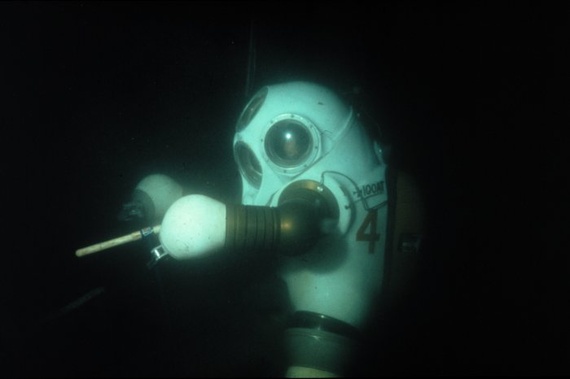Turns out I have enough “clever engineering” links for that to be the theme for all seven takes. First up, a story I’ve been itching to link to since the Olympics: the New York Times put together an awesome interactive spread on the design of pads, helmets, skates, and other accouterments of the Winter Games.
Here are some of the cool things I learned just about the shoes:
- Biathlon: Only the toe of the boot attaches to the ski. The free heel allows athletes to take full strides across the snow.
- Curling: Curlers glide behind the stones they send across the ice. The bottom of one shoe is covered with teflon to help them slide.
- Hockey: The padding inside a hockey boot may take a long time to break in. To speed up the process, new skates are baked in an oven and the warm boot is molded to the player’s foot.
Ars Technica has a fascinating article on the mechanical calculating machines that use gears and axles, instead of chips and wires, to do the arithmetic that aims the Navy’s bombs.
Analog computers use a common set of mechanical devices to do their calculations—the same sorts of devices that convert the torque created by a car’s engine into turning wheels, lifting valves, and moving pistons. Data is “entered” into analog computers continuously, usually by the rotation of shaft inputs. A mathematical value is assigned to one full 360-degree rotation of the shaft.
In the days of the ancient Greeks, data entry was performed by turning a wheel. In more modern analog computers, variables from sensor data such as speed, direction, wind speed, and other factors were passed by electromechanical connections—synchro signals from gyrocompasses and gyroscopic “stable verticals,” tracking systems, and speed sensors. Constants, like passing time, were input by special constant-speed electrical motors.
Connecting all the shafts together to turn them into a continuous set of calculation outputs is a collection of gears, cams, racks, pins, and other mechanical elements that translate motion into math through geometric and trigonometric principles. This is also done through “hard-coded” functions that store the results of more complex calculations in their precisely machined shapes. Working together, these parts instantaneously calculate a very precise answer to a very specific set of questions: where will the target be when the giant bullet I push out of a 68-foot long rifled barrel gets there, and where do I need to aim to get it there?
When assembled precisely, analog computers can be much more accurate than digital computers on these types of questions. Because they use physical rather than digital inputs and outputs, they can represent curves and other geometric elements of calculations with an infinite level of resolution (though the precision of those calculations is based on how well their parts are machined, and loss from friction and slippage). There are no least significant digits dropped, and answers are continuous rather than dependent on “for-next” clock-driven computing cycles.
Also from the annals of historical engineering feats, the Atlantic has a piece on atmospheric diving suits (essentially walking on the ocean floor in a spacesuit, or a one-person submarine. They profile the historical designs and then explain what elements are being revived today, and what problems they solve.
Via Gizmodo, there’s a story about a village in the Netherlands designed for dementia patients. Instead of restraining or sedating the patients, they revamped a town to remove the environmental dangers and anxiety triggers:
For example, one common symptom is the urge to roam, often without warning, which had led most “memory units” and dementia care centers to institute a strict lock-down policy. In one German town, an Alzheimer’s care center event set up a fake bus stop to foil wandering residents. At Hogeweyk, the interior of the security perimeter is its own little village—which means that patients can move about as they wish without being in danger.
Each apartment hosts six to eight people, including caretakers—who wear street clothes—and the relationship between the two is unique. Residents help with everything from cooking to cleaning. They can buy whatever they want from the grocery. They can get their hair done or go to a restaurant. It’s those basic routines and rituals that can help residents maintain a better quality of living.
I was also reminded of Gracy Olmstead’s coverage of the Belgian town that cares for the mentally ill.
Meanwhile, a scientist is looking at neuropathologies to understand how regular brains work. Dr. Suhkbinder Kumar worked with a woman with auditory hallucinations to learn more about how the brain hears:
One problem has to do with how the studies have been designed. Scientists compare a group of people with normal hearing with another group of people who experience musical hallucinations to see if there are any significant differences in their brain activity. All the variations in each group may blur the evidence for how the hallucinations arise. Sylvia, by contrast, offered Dr. Kumar and his colleagues an opportunity to essentially switch hallucinations on and off in a single brain.
For their experiment, Sylvia put on earphones and sat with her head in a scanner that detects the magnetic field produced by the brain. On the day of the study, she was hearing selections from Gilbert and Sullivan’s “H.M.S. Pinafore.”
Every few minutes the scientists would switch to Bach for 30 seconds, to tamp down the hallucination. When the real music stopped, Sylvia pressed numbers on a keyboard to rate the strength of her hallucinations while the scanner recorded her brain activity.
In Dr. Kumar’s research, laypeople are the subjects of the research. For scientists working on RNA research, laypeople can be assistants. A web tool lets citizen scientists design and test configurations of nucleotides, to see which structures are stable, and why:
A consortium of researchers at Carnegie Mellon, Stanford, and Seoul National University put together what they called a Massive Open Laboratory. Operated through a Web portal called “eterna,” it provides a few tutorials that allow people to bring themselves up to speed on the base pairing rules that govern the structure of RNA molecules. These structures can fold up a linear RNA molecule into a catalytic form or allow it to bind other molecules and proteins. These structures are essential to basic cell functions, such as turning genes into mature messenger RNAs and then converting these messengers into proteins.
Once the tutorial is done, volunteers can start taking part in challenges like the one shown on top. By setting the composition of an RNA’s bases, they can attempt to get it to fold into a structure provided by the researchers. You can then perform further tweaks to make the structure more robust. Through this process, the players get to learn the basic rules of what makes an RNA structure energetically stable.
At least, energetically stable based on calculations. But the Massive Open Lab also had a lab, and after a round of challenges ended, those in lab coats actually synthesized and tested the top molecules. The results were given as feedback to the players, and a new round of challenges began.
In the first round, the current state-of-the-art software did a better job of designing RNA structures than the players did. That didn’t last, though. “As the community gained experience with empirical RNA design cycles,” the authors write, “performance improved, and community submissions converged to successful designs.” By the third challenge, the best player-contributed designs were outperforming the best algorithms; by the sixth round, the median player design was better than the best that the computers could come up with.
Finally, in the most beautiful and day-to-day useful piece of engineering and design, someone is running a kickstarter for 3D-printed armor for Barbies.
For more Quick Takes, visit Conversion Diary!


















